/Vehicles/Axis/Germany/02-mPanzers/PzKpfw4/File/3-Design-bis.htm | Last Up-date:
Panzerkampfwagen IV Medium Tank
Design: Engine Compartment
Le groupe motopropulseur principal était le moteur standard monté sur les chars moyens, le V12 essence Maybach HL 120 TRM, refroidi par eau.
The principal power unit was the standard engine assembled on the medium tanks, V12 gasoline Maybach HL 120 TRM, cooled by water.
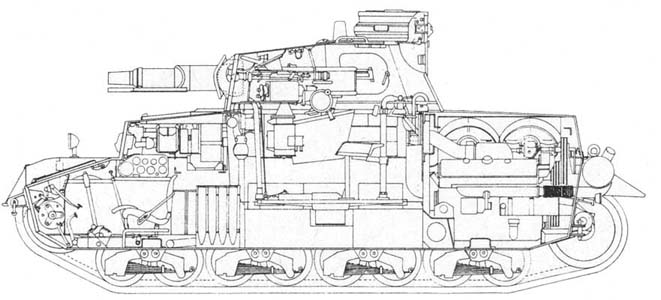 |
Panzer IV
Ausf.D interior details |
src: Connaissance de l'Histoire (Hachette),
n°17
|
Ce moteur pouvait développer 300 ch à 3000 t/m mais en générale se contentait d'un régime réduit de 2600 t/m procurant 265 ch et encore sous climat tempéré. Sous climat tropical il devait se contenter d'un régime réduit de 2200-2400 t/m. Le HL 120 TRM consommait un essence à faible indice d'octane (74). L'huile devait être complètement changé tout les 200, 500, 1000 et 2000 km. L'air nécessaire au refroidissement entrait par les volets situés du côté gauche du compartiment et était aspiré à travers deux radiateurs et au-dessus du moteur par deux ventilateurs à dix ailettes.
This engine could develop 300 hp to 3000 rpm but in general was satisfied with a reduced mode of 2600 rpm getting 265 hp and still under moderate climate. Under tropical climate it was to be satisfied with a reduced mode of 2200-2400 rpm. The HL 120 TRM consumed a gasoline with weak octane number (74). Oil was to be completely changed all the 200, 500, 1000 and 2000 km. The air necessary to cooling entered by the shutters located on the left side of the compartment and was aspired through two radiators and above the engine by two ventilators to ten wings.
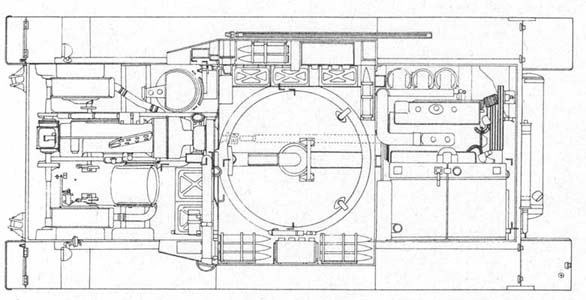 |
Panzer IV
Ausf.D interior details |
src: Connaissance de l'Histoire (Hachette),
n°17
|
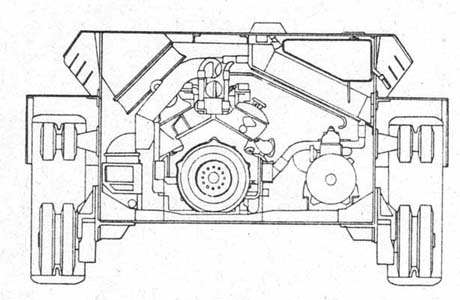 |
Panzer IV
Ausf.D interior details |
src: Connaissance de l'Histoire (Hachette),
n°17
|
Un filtre de grande dimensions fournissait l'air pur nécessaire au groupe motopropulseur. Ce système fonctionnait bien sous climat tempéré mais nettement moins sous climat tropical où le groupe motopropulseur connaissait souvent des pannes et des surchauffes. De plus les filtres à air y était totalement inadéquat et laissait passer beaucoup trop de sable qui bloquait le carburateur. L'entretien se faisait via les trois trappes du plateau arrière. Si nécessaire toute la partie arrière de la caisse pouvait être déboulonnée pour changer le moteur par exemple. Sur la partie arrière on trouvait les silencieux du moteur (cylindre de grande taille) et du système de rotation de la tourelle (petit cylindre ou de forme rectangulaire).
A filter of large dimensions provided the fresh air necessary to the power unit. This system functioned well under moderate climate but definitely less under tropical climate where the power unit often knew breakdowns and overheatings. Moreover filters air was completely inadequate there and let pass far too much from sand which blocked the carburettor. Maintenance was done via the three hatches of the rear deck. If necessary all the hull back plate could be unbolted to change the engine for example. On the back plate found the silencers of the engine (cylinder of big size) and of the system of rotation of the turret (small cylinder or of rectangular box).
 |
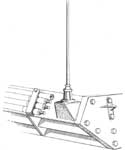 |
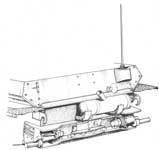 |
Exhaust
models |
Antenna position for the Ausf.H (left side,
rear) |
Antenna position for the Ausf.J (superstructure rear plate) |
src: Vincent Bourguignon |
src: Pz.Kpfw IV
in action, Armor Number 12 (squadron/signal publications, inc.) |
|
Chaque chenille était composée de 99 patins larges de 400 mm (à l'origine 101 patins de 360 mm) et espacés de 12 cm. Il s'agit d'une chenille de type squelette en acier au manganèse de 635 kg. La tension sur la chenille était réglée par une poulie de tension de grand diamètre montée sur un axe centrée à l'arrière du Panzer IV. Le système de suspension comportait 4 supports de galets de chaque côté, équipés chacun de 2 galets estampés de 185 mm de diamètre à bandage de caoutchouc. Des ressorts en quart d'ellipseétaient montés sur le dessous de la fusée d'essieu, en tête de chaque support de galet. L'autre extrémité du ressort prenait appui sur un boulon et un rouleau de jumelle montés sur le prolongement de la fusée d'essieu arrière.
Each track was made up of 99 links of 400 mm (at the origin 101 links of 360 mm) and high of 12 cm. It is about a track of the skeleton type in manganese steel with a weight of 635 kg. The tension on the track was regulated by a rear idler of large diameter mounted on a centered axis to the back of Panzer IV. The system of suspension comprised 4 supports of road wheels on each side, equipped each of 2 stamped 185 mm road wheels with rubber binding. Springs in quarter of ellipse was mounted on the lower part of the stub axle, at the head of each support of road wheels. The other end of the spring took support on a bolt and a schackle roller assembled on the prolongation of the back stub axle.
 |
Panzer IV
typical suspension |
src: Vincent Bourguignon
|
 |
Panzer IV
track models |
| src: Pz.Kpfw IV in action, Armor Number 12 (squadron/signal
publications, inc.)
|
Quatre rouleaux porteur de chaque côtécomplétaient la suspension. Tous ce matériel subira des modifications de détail durant le développement du Panzer IV.
Four return rollers of each side completed the suspension. All this material will undergo modifications of detail during the development of Panzer IV.
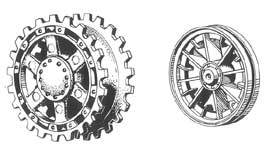 |
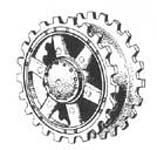 |
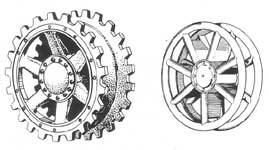 |
Sprocket-wheel
and idler of the Panzer IV Ausf.A |
Sprocket-wheel
of the Panzer IV Ausf.E |
Sprocket-wheel
and idler of the Panzer IV Ausf.F |
| src: Pz.Kpfw IV in action, Armor Number 12 (squadron/signal
publications, inc.)
|
||
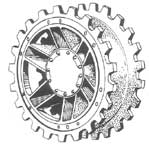 |
 |
Sprocket-wheel
of the Panzer IV Ausf.H/J |
Idler and
steel return roller of the Panzer IV Ausf.J |
src: Pz.Kpfw IV in action, Armor Number 12 (squadron/signal
publications, inc.)
|
|
Toutes les jonctions étaient faites par soudure à l'acier austénitique et les plaques de blindage étaient en acier au chrome et au molybdène réalisé par traitement au four électrique. Le blindage ne cessa d'augmenter durant le développement du Panzer IV passant d'un épaisseur maximum de 15 mm à une épaisseur maximum de 80 mm pour les derniers modèles. Les schémas ci-dessous donnent les chiffres pour le principal modèle de la série l'Ausf.H.
All the junctions were made by welding with the austenitic steel and the armour-plates were in chrome steel with the molybdenum realized by treatment the electric furnace. The shielding did not cease increasing during the development of Panzer IV passer by a maximum thickness from 15 mm to a maximum thickness of 80 mm for the last models. The diagrams below give the figures for the principal model of the series Ausf.H.
| Panzer
IV Ausf.H |
|
 |
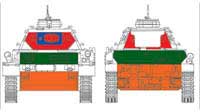 |
Red:
30 mm / 64° Green: 30 mm / 90° Orange: 30 mm / 90° |
Blue:
50 mm / 60-90° Red: 50 mm / 80° Green: 80 mm / 80° Orange: 80 mm / 76° |
 |
|
Red:
15 mm / 0-7° Green: 12 mm / 0-5° Orange: 10 mm / 0° |
|
src:
Vincent Bourguignon |
|
_Ausf.D.jpg) |
Example
of spaced shielding mounted on the Panzer IV. |
| src: Pz.Kpfw IV in action, Armor Number 12 (squadron/signal
publications, inc.)
|
Sources:
- Pz.Kpfw IV in action, Armor Number 12 (squadron/signal publications, inc.)
- Connaissance de l'Histoire (Hachette) - N°17 - " Les chars de combat allemands 39-45"
- Connaissance de l'Histoire (Hachette) - N°5 - " Véhicules blindés allemands 39-45"
- Les Blindés de la Seconde Guerre Mondiale (Atlas)
- Panzerkampfwagen IV Medium Tank 1936-1945 (Osprey Military) - New Vanguard N°28
- Site "Achtung Panzer" - http://www.achtungpanzer.com
- Site "Germany's vehicle history" - http://www.wwiivehicles.com
- Site "Second World War Armour" - http://www.onwar.com/tanks/index.htm